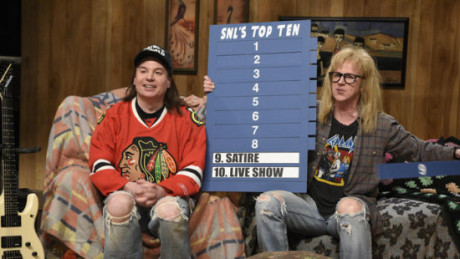Sunday night’s 40th-anniversary special for Saturday Night Live achieved impressive ratings success, averaging 23.1 million viewers during its prime-time hours, Nielsen reports. That’s the highest non-football rating for NBC since the Frasier finale in 2004.
As has been widely reported, the extravaganza included a plethora of big Hollywood stars, plus a smattering of noteworthies from other realms, such as former Alaska governor Sarah Palin. Show business eminences such as Jerry Seinfeld, Steve Martin, Bradley Cooper, and Taylor Swift participated in new comedy bits, and the special included numerous clips from the forty years of the show’s past, as was to be expected.
The new material ranged from somewhat funny (a Celebrity Jeopardy bit and the soap opera parody The Californians) to mildly amusing (the Wayne’s World sketch) to pretty abysmal (Dan Ackroyd’s lifeless recreation of his once-hilarious Super Bass-o-Matic commercial parody) to downright puzzling (Eddie Murphy’s monologue, in which he refused to tell any jokes or say anything interesting).
The musical comedy segments were particularly embarrassing. The opening musical sequence featuring Jimmy Fallon and Justin Timberlake was spectacularly awful, and a segment featuring Martin Short and Maya Rudolph introducing live performances of music (Garth and Kat [Fred Armisen and Kristen Wiig,] Marty and Bobbi Culp [Will Ferrell and Ana Gasteyer,] Opera Man [Adam Sandler,] King Tut [Steve Martin,] Nick Ocean [Bill Murray], and The Blues Brothers) fell horribly flat, except for Murray’s segment, which was terrific. A new “digital short” had Andy Samberg and Adam Sandler singing about how often performers have broken into laughter during sketches through the show’s history, and neither the song nor the brief clips provided any entertainment.
The countless paeans to New York City were harmless though boring and characteristic of the paradoxical provinciality of New Yorkers. The numerous old-clip segments were difficult to enjoy, because the shortness of the excerpts made it hard for the original humor to come across. Nonetheless, millions of viewers stuck with the show over its three and a half hours, eagerly awaiting the amusing moments and star-sightings among the dross. Late in the show a segment in which Jerry Seinfeld took questions from the audience provided some comedy relief.
In sum, the special was not particularly funny, although it did have its moments. It seems that making people laugh was not really the purpose, anyway. The real reason for the special, in addition to luring high ratings by promising participation by a large number of Hollywood stars, was to tell us all just how important and influential Saturday Night Live has been, both to the people who have made the show and to its audience.
Thus the endless parade of SNL grads telling us how much they loved doing the show, and the continual references to how many stars were “born” there. It is undeniable, of course, that SNL has been a comedy star-making powerhouse, and hence it would be culturally important if only for that. And any show that lasts for forty years is significant in that regard. Finally, the number of “catch phrases” from the show that have entered the vernacular is impressive.
Importance, however, is not something we normally associate with successful comedy, or even with satire. Comedy typically makes fun of those who see themselves as important. True satire, similarly, cannot be made by important people; satire is meant to tear down important people who are doing wrong. Among reasonable people, then, the very sense of importance one gets from Saturday Night Live would be the object of derision and satire, not the source of it.
And that, I think, is why I have always been uncomfortable with the show, enjoying it sometimes, but often finding it rather annoying: Saturday Night Live exemplifies political scientist Charles Murray’s observation, in Coming Apart: The State of White America, 1960–2010, that the United States has become increasingly divided into a new upper and lower class distinguished by very different attitudes toward religion, work, marriage, family formation, and personal responsibility.
Murray’s key point in this book is that Americans succeed to the extent that they live out the bourgeois virtues, and those who don’t do so tend to fail. Moreover, Murray notes, the people who populate the nation’s institutions and corridors of power and who create the nation’s culture tend to live by the bourgeois virtues but build a world in which others are discouraged from doing so. This exacerbates the divide and increases income inequality and social stratification.
And that is what one sees in Saturday Night Live and most other late-night TV comedy: a group of highly successful strivers who flout the conventions of behavior to which most people must adhere in order to achieve happiness and prosperity. The TV comedy shows convey an insouciance toward sex, coarse language, irresponsibility, and other such attitudes that would doom the great majority of people to failure should they choose to go and do likewise.
Presumably the people behind Saturday Night Live have nothing of the sort in mind when they put a show together each week. Nonetheless, when watching the self-congratulatory 4oth anniversary special, one cannot help but notice that the attitudes the performers convey in their work are far different from the disciplines that got them to their high perches of success. We used to complain when people failed to practice what they preach; the tragedy today is that so many people fail to preach what they practice.



“We used to complain when people failed to practice what they preach; the tragedy today is that so many people fail to preach what they practice.”
Nails it, Sam. Great stuff!